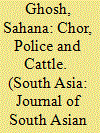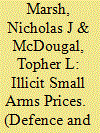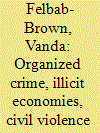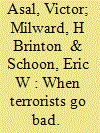|
|
|
Sort Order |
|
|
|
Items / Page
|
|
|
|
|
|
|
| Srl | Item |
| 1 |
ID:
169998


|
|
|
|
|
| Summary/Abstract |
India’s border with Bangladesh figures in the Indian national imagination as a unifying construct for multiple anxieties from illegal immigration to cattle smuggling, thus garnering public support for increased border security. What does a view from the lived and messy realities of the borderlands offer when we shift our focus from the fetish of the borderline as a political and religious marker of difference? This essay tracks the binary of legal–illegal through which cattle in the borderlands are framed, showing how bovines move across different terrains of the agrarian, the sacrificial and everyday cross-border trade in the borderlands and so resist this binary.
|
|
|
|
|
|
|
|
|
|
|
|
|
|
|
|
| 2 |
ID:
178623


|
|
|
|
|
| Summary/Abstract |
Despite calls to reduce illicit arms flows, it remains difficult to detect and quantify them. One proposed method for detecting and quantifying illicit trade volumes is to test econometrically for price changes. This paper documents an effort of the Peace Research Institute Oslo (PRIO) and the Small Arms Data Observatory (SADO) to make such inferential econometric analyses possible by assembling two new datasets on illicit small arms prices. The first, called the ‘Illicit Small Arms Prices – Transactions’ dataset (iSAP-T), has an observational unit of arm(s) sold in a single transaction. The second, called the ‘Illicit Small Arms Prices – Countries’ dataset (or iSAP-C), derives from the iSAP-T and has the more standard country-year observational unit. This paper describes the methods for data collection, organization, and generation for these datasets, presents some descriptive statistics and graphics, and concludes with a discussion of possible future uses and limitations of the datasets.
|
|
|
|
|
|
|
|
|
|
|
|
|
|
|
|
| 3 |
ID:
155234


|
|
|
|
|
| Summary/Abstract |
This essay analyzes the multiple threats that organized crime and illicit economies pose to states and the international order, with a particular focus on the security dimensions of the crime-conflict nexus. In analyzing the range of responses by states and the international community to the nexus of criminal economies and civil wars, insurgencies, and terrorism, this essay also highlights how premature and ill-conceived government efforts to combat illicit economies have counterproductive effects, hampering efforts to suppress militancy and, in some cases, generating dangerous international spillovers of criminality. The second part of the essay examines various pathways out of the conflict-crime nexus, including defeating militants without suppressing illicit economies, suppressing crime and illicit economies without ending conflict, and state co-optation of illicit economies. The essay concludes with policy recommendations.
|
|
|
|
|
|
|
|
|
|
|
|
|
|
|
|
| 4 |
ID:
138303


|
|
|
|
|
| Summary/Abstract |
The intersection of terrorism and organized crime is a central global security concern. However, the conditions that contribute to this intersection or hinder its development are widely debated. Drawing on prominent cases of ideologically driven violent nonstate actors engaged in illicit economies, some scholars argue that this intersection is a logical evolution. Other scholars, focusing on the fact that relatively few groups engage in both organized crime and terrorism, argue that ideological differences hinder this intersection. We use data on 395 terrorist organizations to analyze how organizational and environmental factors affect the likelihood of terrorist involvement in illicit drug trafficking. Our analysis shows that the degree of connectivity within networks of terrorist groups is the most significant predictor of a group engaging in drug trafficking. Further, contrary to the theorized effects of ideology, an explicit religious ideology has no significant effect while an ethnopolitical ideology actually increases the likelihood of drug trafficking.
|
|
|
|
|
|
|
|
|
|
|
|
|
|
|
|
|
|
|
|
|